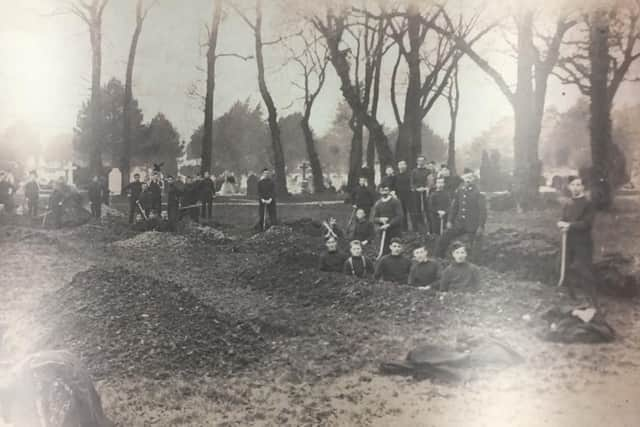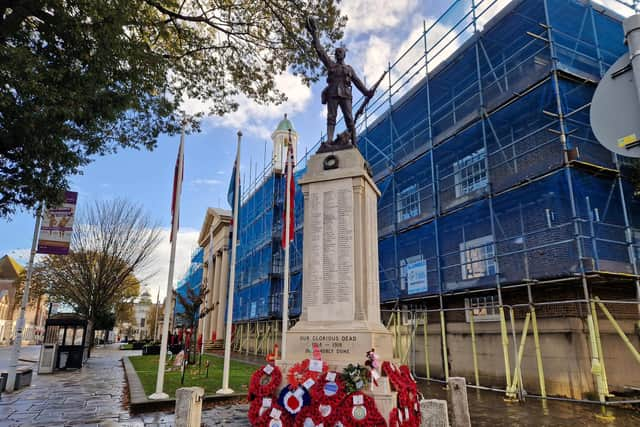From recruitment to remembrance – Worthing in World War One
and live on Freeview channel 276
The group from years seven to nine had worked with Worthing Museum to research what happened in the town during World War One. Pan Panayiotou, executive headteacher, said the students were very proud and honoured to have had the opportunity to take part in the commemoration service.
The students used resources from the museum and the surrounding area for their research and put together a presentation on what they found out.
Advertisement
Hide AdAdvertisement
Hide AdThey discovered the First World War caught Worthing by surprise and when war was declared on August 4, 1914, 'it was almost as if a national holiday had been announced'. Large groups of excited people swarmed around the main streets of the town and on to Marine Parade, singing patriotic songs and waving flats.


The students used local newspapers to find out more about the men who signed up. They learned men aged 19 to 30 were invited to enlist for the duration of the war and competition between towns and villages was encouraged. Those doing well with recruitment were applauded, while others were highlighted if their numbers were considered disappointing.
Worthing was congratulated on producing 365 recruits by mid-August, as reported in the Worthing Gazette on August 19, 1914. The Littlehampton Gazette, however, reported: "The response to Lord Kitchener's appeal has not been so good in the country as in town districts, on account of the harvest."
On December 10, 1914, the West Sussex Gazette reported that the appeal for recruits had been successful, with 2,896 enlisted at the county depot in Chichester.
Advertisement
Hide AdAdvertisement
Hide AdWomen were urged to encourage 'shirkers' and 'idlers' who failed to volunteer, with Captain Matthews telling a Worthing audience that he would like to hear the expression 'no gun, no girl' used more freely.


Further work included looking into The Day Sussex Died and the families devastated by multiple losses. On June 30, 1916, at Richebourg in France, the plan was to launch a diversionary attack on the Boar’s Head stronghold following heavy bombardment of enemy positions.
The aim was to convince the Germans the offensive the following day would take place 25 miles north of the actual planned attack. Approximately 3,000 men from the Royal Sussex Regiment were made available. This was Kitchener's new volunteer army, all from Worthing and other towns on the Sussex Downs and along the coast.
Colonel Grisewold from Bognor Regis said he was not going to sacrifice his men for cannon fodder. He was relieved of duty. The Germans were ready and waiting and after capturing the first trench, the Sussex men had to withdraw due to lack of ammunition and mounting casualties. A total of 366 men were killed and 1,000 were wounded or taken prisoner, including 12 sets of brothers.
Advertisement
Hide AdAdvertisement
Hide AdRobin Marsden-Ibanez, 11, wrote: "It is 1914. Britain and the Allies have declared war on the Axis powers – war has broken out. Many people in Worthing didn’t think much about the outbreak of war, however. While surprised, they didn’t anticipate the conflict in Europe having much effect on their daily life. After people began to sign up following Kitchener’s appeal and the widespread use of the phrase ‘no gun, no girl’, the war seemed closer to home. By mid-August, 365 people had signed up, a figure that quickly rose to 2,896 by December.


"Worthing and the south coast was a home to many local war heroes. One of these was CSM Nelson-Carter from Eastbourne. Nelson-Carter led an attack on the Germans, shooting a machine gunner with his revolver, before taking control of the machine gun, killing four enemy soldiers and saving the lives of seven British Army personnel. Sadly, soon after this heroic act, he died, being posthumously awarded the Victoria Cross for bravery. Many others lost their lives fighting, including John Searle from Durrington who died aged only 15.
"It wasn’t only people engaged on the front lines who made a difference to the war effort. Those who remained at home also played an invaluable role.
"As the men were at war, the women of Worthing needed to do much of the work at home. Hilda Booth, for example, was one of the first women in the UK to be the taxi driver of a motor vehicle. Meanwhile, Lucy Gertude started work at the age of 15 before going onto join the airforce.
Advertisement
Hide AdAdvertisement
Hide Ad"War changed Worthing in many different ways, including the names of many places. The Dome, for instance, was originally called the Kursaal but townsfolk deemed its name to be ‘too German’, giving the cinema the name it has today.


"There are many places in Worthing where you can commemorate World War One. The war memorial in Chapel Road was erected in 1921 and continues to be a site of remembrance to this day. The people of Worthing even erected a memorial to remember the messenger pigeons used by Allied forces during the war. The Warrior Birds Memorial is located in Beach House Park, serving as an important reminder of the damage war inflicts on human and non-human life alike."
Year-nine student Ray Bracey wrote: "It is easily forgotten that war once came to Worthing during 1914 to 1918 when many people from Worthing signed up to help defend the honour of their country. At first, the army had trouble recruiting people from Worthing and eventually between the August and December of the first year of the war the appeal was successful and 2,896 people had enlisted.
"People in Worthing still supported their country even though they did not enlist in meetings, parades, bands, flags and singing of patriotic songs. Men were often bullied into joining the army and people told them it was shameful not to fight. Posters challenged readers “will you come forward or must recruits be obtained outside the country?
Advertisement
Hide AdAdvertisement
Hide Ad"A brave man called CSM Nelson Carter from Eastbourne signed up for the war he was part of the fourth wave of the assault under great shell and machine gun fire he penetrated the line with a few other men and inflicted heavy casualties with bombs and captured a machine gun turret after shooting the gunner with his revolver. After carrying several mortally wounded men to safety he himself was mortally wounded.
"The war memorial in Chapel Road was placed there in 1921, two years after the war and still stands there to this day."
Worthing's War Memorial was erected by public subscription raised through the Worthing Gazette and unveiled by Field Marshall Sir William Robertson.


Year-eight student William Page wrote: "On the 4th of August 1914, war was declared. This caught Worthing by surprise, few had any interest in continental politics. People treated the event as a national holiday, oblivious to the horrors that would soon unfold.
Advertisement
Hide AdAdvertisement
Hide Ad"As you would probably expect, a war needs soldiers to fight in it, and those soldiers have to come from somewhere. Very quickly people began to recruit and Worthing had produced 365 eager young soldiers by mid August. Local publications started publishing the numbers of men who had gone to fight for their country, congratulating our little seaside town for reaching this impressive milestone.
"Some may remember a time when the Dome cinema was named, The Kursaal meaning cure hall. It was named the Dome after a contest to decide what it would be called, this was because Kursaal sounded too German. At the time it functioned as a health and entertainment centre but now it is one of the oldest working cinemas in England.
"During World War One a local woman named Hilda Booth became one of the first women to drive a motorised vehicle. Many people believed that this was ‘not an appropriate occupation for a woman’, however a protest took place and she won the right to work as a taxi driver. The Worthing Gazette called her victory ‘a sign of the times’.
"Things have changed since then but others have stayed the same, whilst our local cinema is still known as The Dome, the idea of sending a child off to war is unthinkable in the 21st century."
Advertisement
Hide AdAdvertisement
Hide AdJacob Roddis wrote: "It was dark and gloomy day. There were destroyed buildings and no one knew what it was really like. They made it look fun in the leaflets. The reality was nowhere near the way they said it would be like. Don't forget the heroes.
"In England it was really bad. Manchester and London were the main targets of the bombing because of the capital and Manchester was bombed because of surplies and food cargo.
"It came to an end because of the US joining. They brought planes and tanks, which lead to a German attack failing. The British used a blockade to stop the German food supply. This lead to riots in Germany and that meant there was a new leader for Germany. The German government decided to surrender.
"In Serbia, there was an assassination of Franz Ferdinand. The assassination was only possible because the driver took a wrong turn. The assassin shot their bullets and killed Ferdinand and his wife."